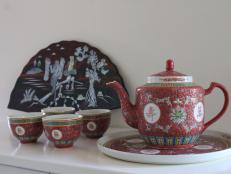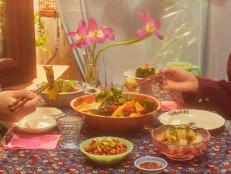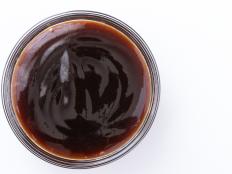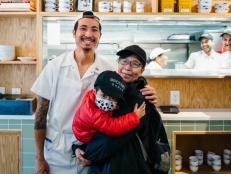Why I Can't Live Without Dim Sum
Dim sum has been at the center of some of my biggest life moments.

Photograph by d3sign/Getty Images
“There is no life without dim sum.” I’ll always remember the day my aunt whispered those words to me. As I think back to them now, I have to admit that I absolutely agree with her: I picked an apartment in San Francisco because of its close proximity to my favorite dim sum spot; had my first date with my now fiancé at dim sum; and then introduced him to my family over dim sum. Suffice to say, dim sum has played an extremely important role in my life.
When I was growing up, my family would always gather for long weekend mornings at Li Wah, our go-to dim sum restaurant in Cleveland, Ohio. Yum Cha, which means "drink tea" in Cantonese, is what we'd call the act of going to dim sum. Yum Cha, for Cantonese people, is a whole culture and ritual. Whenever we traveled to Hong Kong to visit family, our very first morning in the city was always spent catching up over dim sum. Even today, I still seek out the best dim sum in every city I visit. But my early memories of mornings spent feasting on steamed dumplings and lotus leaf-wrapped sticky rice with my family in Cleveland is how I fell deeply in love with dim sum.
Li Wah was the only option in Cleveland for quality dim sum for a very long time; after visiting other mid-sized Midwestern cities, I’m very grateful we even had a dim sum restaurant at all. Li Wah has a large banquet hall, fish tanks along the wall, a golden sculpture of a phoenix and dragon and push carts filled with a vast array of delicious bites. Their dining room became a watering hole of sorts for local Chinese families. It was a place where my parents and grandparents often spotted an old friend. My pau pau (grandma) was best friends with the aunties pushing the carts, and would usually get us the steamer with the largest, juiciest har gow (shrimp crystal dumplings) and siu mai (steamed pork dumplings). I often sat next to my goong goong (grandpa) because he would tell me how each of the dishes were prepared. We shared a love for wu gok (fried taro dumplings); both of us were obsessed with the textural contrast of the creamy interior and delicately crunchy exterior. We would always split one as soon as it reached our table.
My mom was typically in charge of ordering for us. She would intently survey the circulating push carts in the banquet hall to see what our options were, tracked their path throughout the hall and then made good (but not too intense) eye-contact, so the cart reached our table first. This was an important step that ensured we got the freshest egg tarts every time.
Just like any ritual, we always had the same dishes on the table. There had to be at least five orders of plain cheung fun (rice noodle rolls) with soy sauce for the kids (and adults too). I consider this the “mac and cheese” of picky Chinese kids, but even adults love their chewy and silky texture. Then, we needed to have a few steamers of the classics: har gow, siu mai, lo mai fan (sticky rice), char siu bao (bbq pork buns), steamed spare ribs and chicken feet (one of my favorites!).

Photograph by Kristina Cho
Dim sum was never over until everyone had a freshly baked dan tat (egg tart) or two. If we had room to indulge in some more sweets, we would order a few bowls of tofu and mango pudding. If the mango pudding is made with fresh mangoes, it’s one of the most heavenly desserts! Today, when I see big piles of beautiful mangoes at my local Asian grocery store, I stock up on them and make my own Mango Pudding Cups (pictured above). They're surprisingly easy to make, only require a few ingredients and taste so luxurious when you add a generous drizzle of condensed milk on top of them.
Growing up, I thought everyone spent their Sunday mornings feasting on dumplings, and over the years, I’ve introduced countless friends to dim sum. Sharing my love of dim sum is one of the easiest ways for me to share an important facet of my culture with others. Of course, through eating dim sum, you learn about sweet and salty flavor profiles, the chewy texture of sticky rice and steamed buns and the aromas of lotus leaves and chrysanthemum tea. But at the dim sum table, you also learn a lot about patience and generosity, which is so integral to Chinese culture. The tables are often fitted with a lazy Susan, which is filled with platters and steamer baskets of food. You learn to pay attention to those around you — you don’t turn the lazy Susan while someone else is grabbing something. You also learn to always pour some tea out for your neighbor first, before pouring some for yourself. The same can be said about taking the very last dumpling — always ask the table first (multiple times even!) before finishing a steamer.
I have so many foundational memories centered around the dim sum table. I can still hear the distinct sound of clinking china, Cantonese chatter and the squeaky cart wheels of the banquet hall. The food, the atmosphere and the people tethered to dim sum carry so much meaning to me. A bite of siu mai is more than a pork dumpling — it immediately connects me back to my family, and fills me with a lot of pride for my culture. I can’t go too long before a deep craving for dim sum creeps over me. Thankfully, I’ve made sure never to live too far away from excellent dim sum, because, honestly, I can’t live without it!
Kristina Cho is a food blogger (@eatchofood) and cookbook author based out of the San Francisco Bay Area. Her debut cookbook, Mooncakes and Milk Bread, is an evocative and long-overdue celebration of Chinese baking that brings together personal storytelling with fresh, uncomplicated interpretations of classic recipes for the modern baker. The book was released to much acclaim and named one of the Best Cookbooks of 2021 by The New Yorker.
Related Content:

































